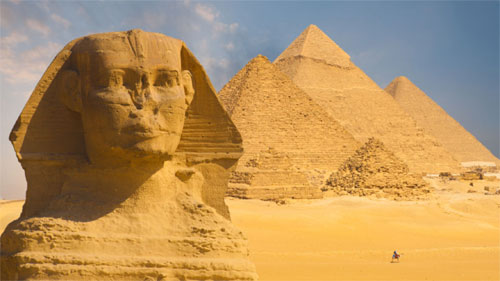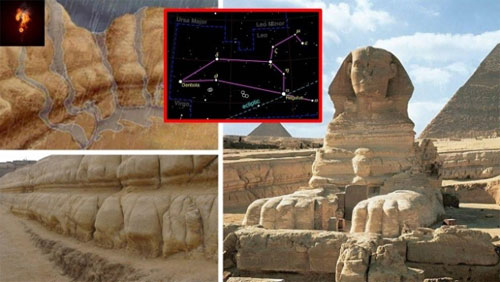Multiple Researchers: Great Pyramid And Sphinx Are much Older Than Previously Thought
The Great Pyramid and surrounding pyramids at the Giza complex are much older than 4500 years old, as Egyptologists claim. New research, conducted by scientists free to think outside of the box, agree that this figure isn’t right.

Egyptologists assert that markings made by a “work gang” in the Great Pyramid, allegedly from the fourth dynasty, cite Pharaoh Khufu. And this, to them, proves it was made during his time.
But this argument isn’t proven because stone, in this case limestone, cannot be carbon dated since it is not an organic material. There’s no concrete proof it was built during Khufu’s reign. This means, from an epistemology perspective, the Khufu claim is more akin to accepted myth and academic doctrine, than substantiated fact.
Why Does This Matter?
There are multiple reasons why this is important ranging from understanding the complexities of this ancient civilization to reconstructing what we know as the story of humanity and how we evolved on the planet.
The lack of an evidence-based argument for the age of the pyramid leaves the door open for other researchers and those that have stepped up to the plate haven’t disappointed us.
Robert Schoch
Robert M. Schoch is a professor at the College of General Studies at Boston University. He claims that the Great Sphinx, which sits in front of the Great Pyramid complex at Giza is about 13,500 years old.
He cites water erosion patterns as proof some kind of major catastrophe took place in antiquity, wherein large volumes of water were washing over the plateau.

Egyptolosts assert that the Sphinx was built during Pharaoh Khafre’s reign (c. 2558–2532 BC), a few short decades after the date cited above. But Egyptologists reject Schoch’s research, which has been summarily ignored by academics. However, no valid counter argument is provided.
A valid counter argument is important because, in the scientific process, claims need to be evidence-based. Schoch provides superior evidence for his age of the Sphinx, citing weather erosion on the Sphinx itself and surrounding rock face.
This means, if Egyptologists wanted to truly debunk his claims, they’d have to incorporate his evidence, namely by providing a better explanation as to why there are water erosion patterns.
This suggests Schoch’s numbers are the more accurate ones, at least until more evidence becomes available.
Although Schoch’s claim doesn’t directly relate to the age of the pyramids, it is believed that they were likely built by the same much more ancient civilization. What could that civilization be? Some claim the legendary Atlantean civilization discussed by Plato.
View Robert Schoch’sDetailed Presentation at the Portal to Ascension Conference 2018 where he explains the science and geology behind the dating of the Sphinx.
Graham Hancock
Graham Hancock is a journalist and author, who has written several New York Times Best Sellers. He’s known for his exploration of ancient history.
In this instance, Hancock worked with Robert Bauval to bring forth the Orion Constellation Theory, which claims that the Great Pyramid Complex is almost a perfect match for the Orion Constellation. Given this, Hancock and Bauval both claim that these megaliths could be at least 12,000 years old.
Other researchers, such as Billy Carson from 4BiddenKnowledge date the Sphinx to an even earlier period 36,000 years ago claiming that Leo was the constellation that the Sphinx was facing and that it would not have been possible to build the Sphinx 13,500 years ago due to the conditions of the terrain since the planet was coming right out of an ice age.
View Billy Carson’s Presentation at the Portal to Ascension Conference 2018.
Younger Dryas Impact
Multiple researchers, including Hancock, cite the Younger Dryas impact theory as evidence some massive cataclysm changed the face of the earth some 12,000 years ago.
Additionally, mainstream research suggests the Sahara desert was flooded by monsoon rains about 10,000 ago. Could this be the source of the water erosion patterns mentioned by Schoch?
Legends Of Atlantis
No discussion of the pyramids would be complete without mentioning Atlantis.
Atlantis is a legendary highly advanced civilization from antiquity, which some say could have been a global civilization. Plato is the most widely cited source for this, mentioning Atlantis in Timaeus and Critias.
In that work, Solon, a poet and law maker, claims to have visited Neith, where priests he met there told him of historic accounts of Atlantis. Solon is believed to be a real person. And so, while Plato’s dialogues are fictional, they are considered laden with true history.
Atlantis, is so widely discussed by so many people, from academics and archeologists, to ufologists, spiritualists, and even mediums. While not every claim matches up, dozens share the same basic narrative.
The story is that Atlantis was a highly advanced global civilization that appeared around 30,000 to 40,000 years ago.
They used advanced technology that we would regard as magic, such as free energy devices, portal technology, stargates, and spacecraft. Some even say that this civilization also colonized planets and moons in our solar system.
The common threads that relates to this discussion is when and how Atlantis fell. Almost all these alternative sources suggest that when Atlantis fell, the whole of the civilized world at the time went with it.
For thousands of years, humanity was effectively thrust back into the stone age. And then, seemingly out of nowhere, the Sumerian civilization burst onto the scene, complete with a financial system, legal system, agriculture, and fairly advanced technology at the time.
How Is This Possible?
Mainstream historians can’t answer this question. But anyone with common sense would likely agree that the Sumerian culture was likely influenced by a much older civilization.
Furthermore, would it not make sense that the erosion patterns on the Sphinx point to a time when water was more abundant? And that the Pyramids are most likely an artifact of a much older, advanced civilization?
If all of this isn’t enough to at least spark your curiosity, consider these amazing facts about the Great Pyramid:
– There are over 2 million stone blocks in the Great Pyramid, weighing anywhere from 2 to 50 tones.
– The Great Pyramid is aligned 0.067 degrees counterclockwise from perfect cardinal alignment of true north. Modern day buildings are not built with this level of precision.
– The Great Pyramid is “earthquake proof” — the irregular blocks make an almost invincible structure.
– The Great Pyramid is actually 8-sided, with such precision that, for decades, historians never noticed.
– The Great Pyramid encodes fundamental mathematical constants like the pi and phi ratios.
– The Great Pyramid, as Hancock and Buvaul assert, is an almost perfect reflection of the constellation of Orion.
– The Great Pyramid can focus energy within its various chambers.
– Last in this short list, a large void or cavity was recently detected inside the Great Pyramid.
These are just a few mysterious facts that leave modern-day scientists baffled.
Conclusion
Despite what mainstream media and academia contend, we know very little about arguably the most fascinating of the seven wonders of the ancient world.
The philosophy of knowledge, epistemology, helps us sort fact from fiction. Using these tried and true tools of analysis, the very same tools at the heart of science, the accepted age of the Great Pyramid is highly suspect.
There’s more evidence to support Schoch’s claim than there is to confirm official dogma coming from Egyptologists.
The internet has given humanity an unprecedented ability to question official claims. In the past, researchers like Schoch and Hancock would probably never had a chance to share their valuable research.
yogaesoteric
June 25, 2020
